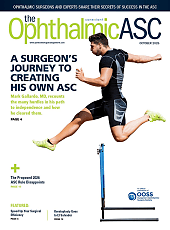In this issue, we discuss the importance of reimbursement for corneal tissue. Corneal disease is the fourth leading cause of blindness worldwide and the second leading cause of blindness in under resourced countries.1,2 We are fortunate here in the United States that we have access to corneal tissue and skilled surgeons and facilities in which to perform sight-saving corneal transplants. Corneal transplantation is the most common form of organ and tissue transplantation performed.3
Today we have the ability to perform less invasive partial cornea transplant techniques such as DMEK (Descemet’s membrane endothelial keratoplasty) and DSEK (Descemet’s stripping endothelial keratoplasty) for endothelial disease such as Fuch’s dystrophy, as well as DALK (deep anterior lamellar keratoplasty) for corneal blindness from stromal disease such as scars or keratoconus, where the endothelium is unaffected and may be preserved. These less invasive procedures preserve more of the healthy host cornea and are faster healing, provide better potential vision, require less follow-up care and have a decreased risk for intraoperative and postoperative complications. According to one study, “the DMEK eyes had a 15 times lesser risk of experiencing a rejection episode than DSEK eyes and 20 times lower risk than PK eyes.”4
These innovations require transplant tissue to be processed and pre-cut for surgical use, which adds additional cost to the tissue. When viewed as a complete process from tissue preparation and processing to the final visual outcome and quality of life measures, the relatively small increased cost of the tissue is actually more cost effective overall. In addition, the decreased intraoperative and postoperative complications, and fewer patient visits contribute to the total cost savings for these procedures. Current data from the Eye Bank of America Association (EBAA) show that of the 55,000 transplants performed in the United States; the majority are DMEK, then DSEK, and a minority are PK.5
Unfortunately, a number of commercial insurance companies will cover only the cost of PK tissue, and not the more expensive pre-cut DMEK or DSEK tissue. Medicare (but not all Medicare Advantage products) is currently the only insurer that reliably covers the cost of corneal tissue as a “pass-through” expense for ASCs. Other insurance carriers may cover some, none or all the costs associated with corneal tissue. This is insurance- and state-specific, and based upon the contract that the ASC has with the insurance carrier. Eye banks including CorneaGen and the EBAA can provide resources to help ASCs navigate the insurance quagmire of corneal reimbursement.
What’s to be done? A concerted effort is needed from ASC managers, surgeons, medical directors of ASCs, ophthalmology societies and eye banks to reverse this trend and work to obtain “pass through” status for all corneal tissue. We need to educate insurance companies about how their policies create barriers for patient access to care as well as how providing coverage for corneal tissue can lead to overall cost reduction for them.
Additionally, we must inform patients that they can and should advocate for themselves by contacting state insurance commissioners and their own insurance companies (If they can find a way to get through to a human!). In the United States, we should not have patients denied access to care for treatable forms of corneal blindness. OASC
References
- World Health Organization. World health statistics 2015. https://www.who.int/gho/publications/world_health_statistics/2015/en/. Accessed 20.02.19.
- Oliva MS, Schottman T, Gulati M. Turning the tide of corneal blindness. Indian J Ophthalmol. 2012 Sep-Oct;60(5):423–427. doi: 4103/0301-4738.100540. Accessed March 30, 2025. https://pmc.ncbi.nlm.nih.gov/articles/PMC3491269/
- Aliouche H. How Does a Cornea Transplant Work. News-Medical.Net. https://www.news-medical.net/health/How-Does-a-Cornea-Transplant-Work.aspx. Accessed March 30, 2025.
- Anshu A, Price MO, Price FW. Risk of Corneal Transplant Rejection Significantly Reduced with Descemet’s Membrane Endothelial Keratoplasty. Ophthalmol. 2012 Mar; 119:536-640. doi: 10.1016/j.ophtha.2011.09.019. Epub 2012 Jan 3. https://pubmed.ncbi.nlm.nih.gov/22218143. Accessed March 30, 2025.
- Eye Bank Association of America. Statistical Report. https://restoresight.org/members/publications/statistical-report/. Accessed March 30, 2025.









